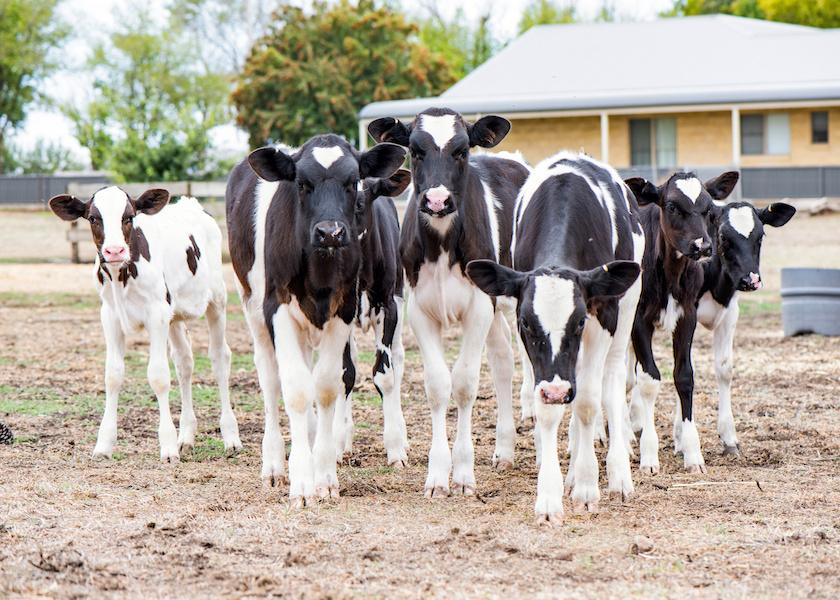Seven Tips to Help Calves Beat the Heat

It’s summertime, and the livin’ is easy – except not for calves, who suffer heat stress right along with their older herd mates.
While calves have a larger surface area relative to body weight, and don’t generate as much body heat as adult cows, they are at risk of heat stress, nonetheless. Calves’ smaller body mass and weight means they dehydrate more quickly than cows. Numerous studies also have shown that calves born in the summer have sub-par bodyweight gain compared to their peers born in cooler months. And their less-developed immune systems also make them more vulnerable to stress-related illnesses.
Here are five strategies to help mitigate heat stress and keep calves healthy and growing through the peak heat of summer:
- Provide shade – Calves in hutches may have a hard time escaping heat, especially when outdoor temperatures are excessive, because they have a hard time finding relief either indoors or outdoors. Installing 80% shade cloth about 4 feet over hutches has been shown to reduce the interior hutch temperature by 3F and calf rectal temperature by 0.5F in an Alabama study.
Hutches also can be placed under natural shade from trees as an alternative. Calves housed in barns have natural shade, but be sure to watch for “hot spots” where they are not protected during certain times of the day. Installing and adjusting curtained sidewalls can help manage sun exposure in buildings.
- Create airflow – University of Pennsylvania Dairy Extension educators Coleen Jones and Jud Heinrichs suggest that, typically, open-faced buildings should face southeast, and hutches can be positioned to face east in the summer to maximize air movement and minimize solar heating. Hutch vents should be opened, and Washington State University research has proven the merits of elevating the back of hutches with a concrete cinder block (7.9 inches high) to encourage airflow reduce calf respiration in hutches. Building ventilation systems will vary, but maximizing both natural and mechanical ventilation will help keep calves cool, improve air flow and quality, and reduce pathogen growth.
- Water, water, water – Calves need water to maintain body temperature. In hot weather, they lose more water through increased respiration and sweating. Michigan State University Dairy Extension educator Cora Okkema said an Iowa State University study showed calves with continuous access to fresh, clean water starting at birth had better rumen development, improved nutrient digestibility, and higher growth rates compared to calves whose water accessibility was delayed to 17 days of life. Okkema noted that older calves can consume 2-3 gallons of water per day, so attention to water delivery throughout the day is important. Several suppliers also offer oral electrolyte products that are used ad-libitum in drinking water for preweaned calves under severe heat or transportation stress.
- Keep grain fresh – Flies, mold, and heat spoilage all are greater challenges for feeding starter grain in the hotter months. But because calves also eat less grain when they are hot, it’s important to keep the grain supply as fresh and appealing as possible. Jones and Heinrichs suggested feeding just a few handfuls of grain until calves are eating it readily, and discarding uneaten portions. A divider between grain and water buckets – or complete separation between these two feedstuffs – will help prevent grain contamination and spoilage.
- Use inorganic bedding – Many producers prefer sand bedding in the summer months to help keep calves cooler. Regardless of bedding used, it should be clean and dry to encourage calves to rest.
- Bump up nutrients – Cold stress tends to get more attention than heat stress when it comes to adusting liquid rations. But calves need more energy to regulate their body temperatures in periods of heat stress, too. And, unlike wintertime when calves can eat more starter grain to partially fuel their increased energy needs, they are likely to eat less starter grain than normal in hot weather. That makes the liquid ration the more logical means of delivering more nutrients. This can be accomplished by adding an extra daily feeding, boosting solids, or feeding more of the standard ration at regular feeding times, on the advice of your herd nutritionist.
- Adjust management practices – Jones and Heinrich suggested avoiding the heat of the day for tasks like dehorning, castration, vaccination, pen sorting, and transportation. All of these tasks are best performed early in the morning when both environmental temperatures and calf body temperatures are at their lowest point in the day.
Finally, Okkema advised to “take care of your caretakers.” She said, “The summer heat is hard on everyone. Tempers flare, patience is thin, people get tired more quickly, and the idea of taking shortcuts is all-too-appealing.”
She suggested keeping a refrigerator stocked with snacks and drinks, encouraging regular cooling breaks, and educating workers about the symptoms of heat exhaustion and heat stroke.
For more on calves and heat stress, read:







